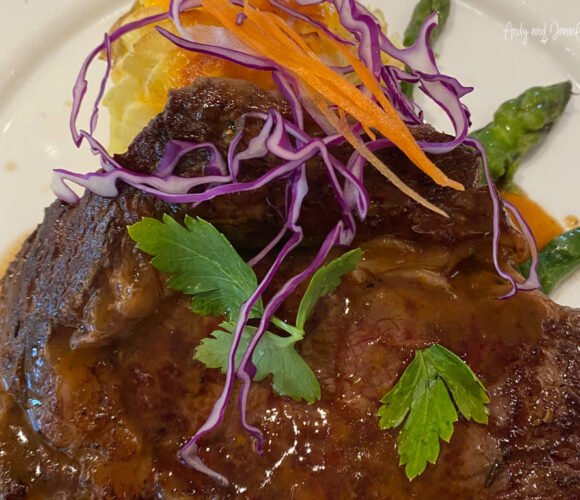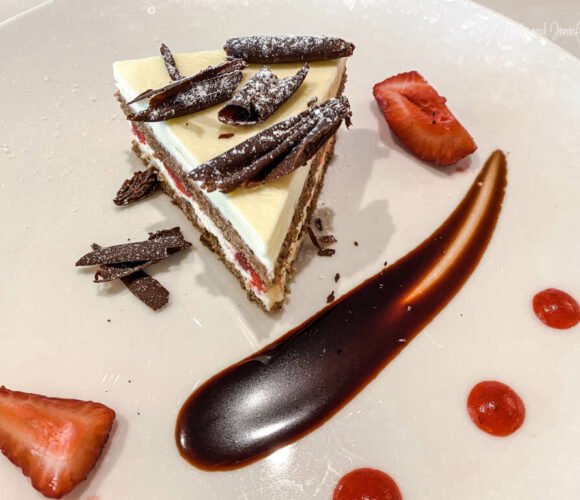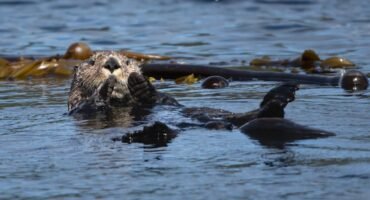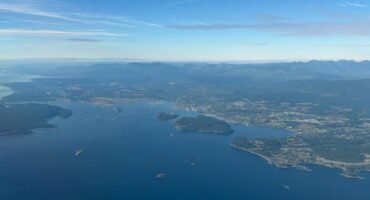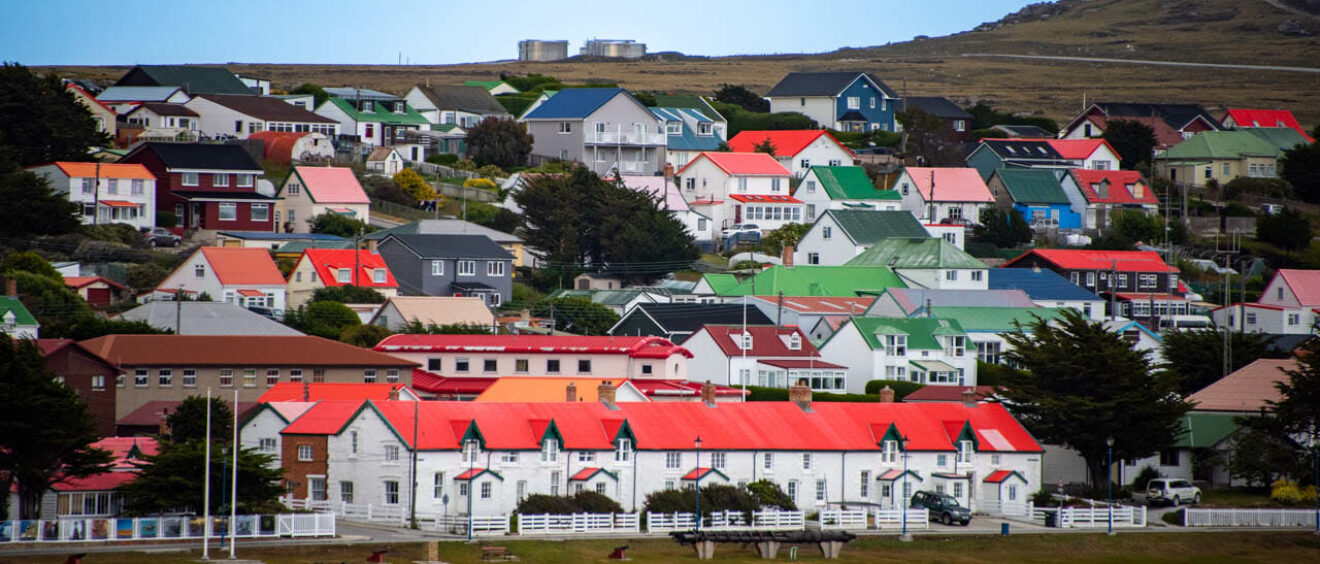
The Falkland Islands
This post is part of our epic adventure to the Falklands, South Georgia, and Antarctica. In case you don’t want to read this sequentially, or you are looking for a specific part of the trip, here are some shortcuts:
- Introduction
- Departure Day
- Santiago, Chile
- Torres del Paine, Chile
- El Calafate, Argentina
- Ushuaia, Argentina
- Embarkation Day
- Stanley, Falkland Islands <-- You are here
- Sea Days
- Tour of the Ship
- Right Whale Bay, South Georgia
- Salisbury Plain, South Georgia
- Grytviken, South Georgia
- Fortuna Bay, South Georgia
- Stromness, South Georgia
- Godthul, South Georgia
- St. Andrews Bay, South Georgia
- Gold Harbour, South Georgia
- Cooper Bay, South Georgia
- The Scotia Sea Surprise
- Cuverville Island, Antarctic Peninsula
- Port Lockroy, Antarctic Peninsula
- The Drake and Ushuaia, Argentina
At Sea and the Falklands – December 29th and 30th
51°40’3″ S, 057°49’6″ W

Greg’s trademark “Good morning Good People” announced that we’d made good progress overnight due to a decent tail wind. We both had a fairly good night’s sleep and neither of us were feeling seasick at all. There was a mild swell and we were beginning to get our sea legs.
Mornings on the ship followed the same schedule daily. Coffee and pastries were available in the lecture theatre at 7 for early risers, and then breakfast at 8 or 8:15am depending on your colour group. Breakfast was a substantial buffet, with eggs cooked to order. Due to my onion allergy, the restaurant manager would bring me the menu for the next meal at the end of each meal, noting what was safe and what to avoid. It was really challenging to try to keep distance from other people at meals, and we eventually just gave up trying. As this was a 21 day expedition cruise to Antarctica, all of the people we met were wildlife, outdoor, travel and adventure enthusiasts which made for some really interesting mealtime conversations.
After breakfast, we gathered in lecture theatre for the mandatory IAATO briefing which covered the strict biosecurity protocols and how to respectfully behave around wildlife. We then headed down to the mudroom to get our muckboots, which were a lot more comfortable than I’d imagined. We then went back to the lecture theatre for Covid test #2, and the entire boat tested negative which was a huge sigh of relief.

We had a snorkel briefing after lunch in the observation lounge and met the snorkel guides Andrew (from Sydney) and Hannah and Patrick (from Port Lincoln). I’m 99% sure I knew Hannah from one of our sea lion trips – such a small world! There were 10 snorkelers, and the plan was to get fitted for dry suits en route to South Georgia so we could do a checkout snorkel when conditions permitted. I was concerned that we would miss landings if we were snorkelling, but it turned out that snorkellers were in the first group ashore, and we would wear our drysuits and go for a snorkel after the landing. Sounded like a good plan, assuming the drysuits weren’t too cumbersome.
In the afternoon, Ben gave an interesting lecture on the history of the Malvinas/Falklands. We had a 30 knot tail wind, and barf bags had appeared in the hallways, but we were both still doing fine with just the wrist bands.

The evening routine typically followed the same schedule each day, with a daily recap in the lecture theatre, followed by drinks and then dinner based on colour group. Dinner tonight was preceded by the Captain’s welcome, where he introduced himself and the key officers. Unfortunately the usually open bridge was closed due to Covid, but as the entire boat tested negative, he was hopeful bridge tours could resume at some point during the voyage.

Each night we’d return to our cabin, the drapes would be closed, the bed turned down and topped with a “Penguin Post” recapping the day’s adventures. There was also an app that had the daily schedule, which was also available on the TV. Basically every time we left our room, our cabin attendant would sneak in and tidy up.

The next day started with an early wake-up from Greg announcing that we were approaching the capital of the Falkland Islands, Stanley. We went up to Level 7 to watch the captain negotiate the narrow entrance to the harbour and get our first glimpse of Stanley.



We were told to prepare for a dry-ish landing via zodiak, which meant we should wear our polar jackets but there was no need for muckboots. We were also warned to really try to avoid Covid exposures in town. This didn’t impact us too much, as we didn’t have plans to sit in a pub, and we’d successfully avoided Covid since the pandemic began and had a booster six weeks ago. We were on one of the first zodiaks to go ashore, and while my rain pants and jacket worked great as the waves crashed over the zodiak, my hiking shoes and socks were absolutely soaked. There were a few South American sea lions lounging on the jetty as we arrived, and I could have stayed there and watched them all day.

There were a few organised tour options: a photography tour with Adrian, a bird walk with Ade, or a 7km group coastal walk. We decided to walk around town on our own and then go out to Gypsy Point. The main town of Stanley is about 2.5 square kilometres (about 1 square mile) so our lap took about an hour. It was very British-looking, there were lots of churches, and it seemed like every vehicle was a Defender.




Back at the visitor centre, we hired a taxi ($25pp) to take us out to Gypsy Point to see the Magellenic penguins. We saw a few in their burrows with chicks, as well as Kings and Gentoo down on the beach (but we didn’t know we were allowed to walk closer).









It looked like rain was approaching, so we went back to the ship for lunch. I tested using the heated bathroom floor to dry my socks and it worked like magic.
In the afternoon, Marion presented the different citizen-science programs we could participate in during the expedition. Hannah gave a presentation on sea lions, and Ade showed us how to properly use binoculars. It may sound like there are a lot of lectures and presentations, but each presenter brought their unique personality and style and were all super interesting. The lectures were also broadcast to the TV in our cabin.

And here’s what we ate for dinner 🙂
That evening, we lifted anchor and prepared for two days at see en route to to South Georgia.

Next up — Sea Days
We’re Andy and Jennifer—two former corporate executives who chose long ago to prioritise experiences over stuff while pursuing our passions for travel and photography. From the Arctic to Antarctica, and most places in between, we’ve captured the world through our lenses and love sharing those stories. Our careers gave us the means, but our purpose is inspiring others to explore and helping people create images they’re proud of.

